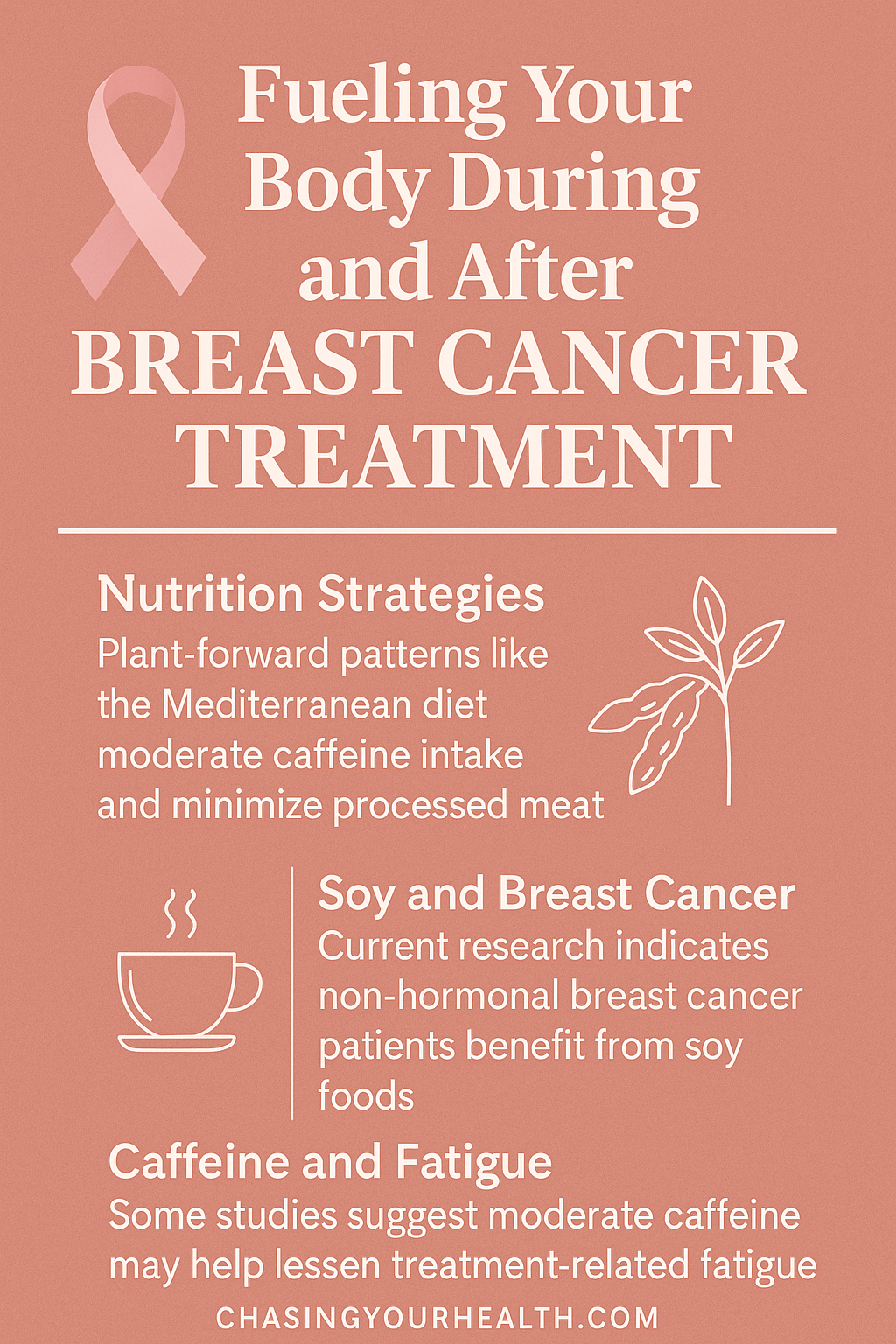Fueling Your Body During and After Breast Cancer Treatment
October is Breast Cancer Awareness Month—a time when pink ribbons, survivor stories, and early detection reminders fill our newsfeeds. But beyond awareness lies an often-overlooked part of the journey: how you fuel your body during and after treatment.
Nutrition isn’t a cure, but it is a powerful form of medical self-care. What—and how—you eat can influence energy levels, side effects, immune health, and even long-term recovery. Let’s walk through what current research and medical nutrition therapy tell us about eating for healing, strength, and survivorship.
💗 A Personal Note
Cancer isn’t just something I talk about as a dietitian—it’s something that’s deeply personal to me. My grandmother fought breast cancer that ultimately spread. My grandfather also faced his own battle with cancer. I’ve watched some of my greatest friends walk through breast cancer with courage that humbles me. And most profoundly, my son has faced leukemia (AML), too.
So when I write about nutrition and cancer, it’s not just from research or professional experience—it’s from love, loss, and lived perspective. I know the weight of the word cancer. And I also know the strength that comes from nourishing your body, caring for your health, and finding hope even when things feel uncertain.
This month, and always, I honor the fighters, the survivors, and the families who never stop showing up. 💕
Why Nutrition Matters During Treatment
Chemotherapy, radiation, and hormonal therapy can take a toll—altering appetite, taste, digestion, and metabolism. Thoughtful nutrition helps your body manage that stress by:
Supporting immune and wound-healing function
Preserving lean muscle and bone mass
Managing fatigue and inflammation
Aiding recovery and promoting long-term health
Nutrition is more than calories—it’s a cornerstone of your treatment plan.
🥗 1. Embrace a Plant-Forward, Mediterranean-Style Eating Pattern
Research consistently shows that plant-forward and Mediterranean diets support better outcomes and overall survivorship in breast cancer.
This pattern emphasizes:
Vegetables, fruits, whole grains, legumes, nuts, and seeds
Healthy fats from olive oil, avocados, and fish
Limited red/processed meats, added sugars, and refined grains
These foods are naturally anti-inflammatory and packed with antioxidants and phytonutrients that help the body repair and protect itself.
👉 Studies link higher adherence to a Mediterranean-style diet with lower all-cause mortality in breast cancer survivors (WHEL, PREDIMED, and AICR reviews).
Pro tip: Aim for two-thirds of your plate to come from plant foods, with the remaining portion reserved for lean protein.
🍗 2. Prioritize Protein—Every Meal, Every Day
Protein is essential for maintaining muscle, rebuilding tissues, and healing.
Include sources such as:
Eggs, fish, poultry, tofu, tempeh, beans, Greek yogurt, or cottage cheese.
If appetite is low, use smoothies or soups with added protein powders or nut butters.
During treatment, some individuals may need 1.2–1.5 g protein/kg/day, but this varies—so partner with a registered dietitian to personalize your goals.
🥑 3. Choose Healthy Fats
Fat isn’t the enemy—it’s part of your healing process. Focus on:
Monounsaturated fats: olive oil, nuts, avocados
Omega-3 fats: salmon, sardines, walnuts, flaxseed
These fats may help modulate inflammation and support heart health—both crucial during survivorship.
🌈 4. Load Up on Color
Fruits and vegetables bring fiber, vitamins, and phytochemicals that combat oxidative stress.
Each color offers different benefits:
Red (tomatoes, strawberries): lycopene, antioxidants
Orange/yellow (carrots, squash): carotenoids
Green (spinach, kale, broccoli): folate and sulforaphane
Blue/purple (berries, grapes): anthocyanins
A diverse color palette = a broader defense system.
💧 5. Hydrate and Support Digestion
Chemotherapy, radiation, and certain medications can dehydrate you quickly.
Sip water, herbal teas, and broths throughout the day.
If GI distress occurs, use small, frequent meals and gentle fiber sources like oatmeal, smoothies, or cooked vegetables.
🩺 6. Address Common Side Effects with FoodPoisoning
Side Effect
Nutrition Strategy
Nausea
Bland foods (crackers, rice, bananas) and cold meals if smells trigger symptoms
Taste changes
Try tart flavors like citrus or pickled vegetables
Fatigue
Eat small, balanced meals every few hours
Mouth sores
Smoothies, soft foods, avoid spicy or acidic items
Constipation
Add fiber gradually, hydrate, move as tolerated
🌱 The Soy Story: From Myth to Science
For decades, soy has been one of the most misunderstood foods in breast cancer nutrition. Many patients were told to avoid it—fearing it might “feed” tumors. That myth came from early lab research, but newer human studies tell a very different story.
How the Soy Fear Began
1990s animal studies: High doses of soy isoflavones stimulated tumor growth in rodents—but those doses far exceed human diets, and rodents metabolize soy differently.
2000s confusion: Isoflavones were labeled “phytoestrogens,” leading to the false idea that soy acts like extra estrogen.
Media oversimplification: “Soy feeds breast cancer” became a viral headline before large-scale human studies were published.
What Research Actually Shows
Shanghai Breast Cancer Survival Study: Women consuming the most soy had ~33% lower total mortality and 34% lower recurrence.
After Breast Cancer Pooling Project: Across ~9,500 survivors, higher soy intake was linked with lower recurrence rates.
Meta-analyses (2022): Confirm that soy foods are safe and may be protective for survivors.
Guidelines: The American Cancer Society and AICR endorse moderate soy intake as part of a healthy diet.
Best forms: whole soy foods—like tofu, tempeh, soy milk, edamame.
Avoid soy supplements or highly concentrated powders unless directed by your medical team.
🌸 From myth to science: soy foods are safe—and may support healing and survivorship.
☕ Caffeine and Breast Cancer: What the Evidence Says
Coffee and tea often land in the “maybe” category, but research continues to support that moderate caffeine intake is safe—and might even help.
Drinking 2–3 cups of coffee daily after diagnosis has been linked to a 25% lower risk of breast cancer–specific mortality.
Caffeine itself isn’t harmful—but watch added sugars and creamers.
Coffee and tea are rich in polyphenols and antioxidants that may reduce inflammation.
Decaf options still offer benefits for those sensitive to caffeine.
Bottom line:
Moderate caffeine (about 2–3 cups per day) is safe for most survivors—just be mindful of sleep, hydration, and how your body feels.
☕ Caffeine isn’t the villain—it’s all about balance and individual tolerance.
📊 How the Soy Story Changed (Timeline Recap)
1990s: Rodent studies spark fear.
Early 2000s: “Phytoestrogen panic” spreads.
2000s Media: “Soy feeds cancer” dominates headlines.
2009–2012: Human data (Shanghai & ABCPP) show soy lowers recurrence & mortality.
2010s–2020s: Meta-analyses confirm safety; major cancer organizations support soy foods.
🥗 Putting It All Together
The best nutrition approach for breast cancer treatment and survivorship is personalized, flexible, and rooted in whole foods.
A balanced plate might look like this:
½ to ⅔ plants (vegetables, beans, grains)
¼ lean protein (fish, chicken, tofu, or lentils)
Olive oil or avocado for healthy fat
Berries or fruit for dessert
Small, consistent habits—not perfection—make the biggest impact.
💬 Final Thoughts
Your body has carried you through diagnosis, treatment, and recovery—it deserves nourishment that restores rather than restricts.
Eating well after breast cancer is not about dieting or deprivation. It’s about healing, empowerment, and connection—finding foods that make you feel strong, energized, and whole again.
“Whole health means caring for your body, mind, and soul. Nutrition is one piece—but it’s a powerful one.”
Keep chasing your health—one mindful meal, one compassionate choice at a time. 🌸


